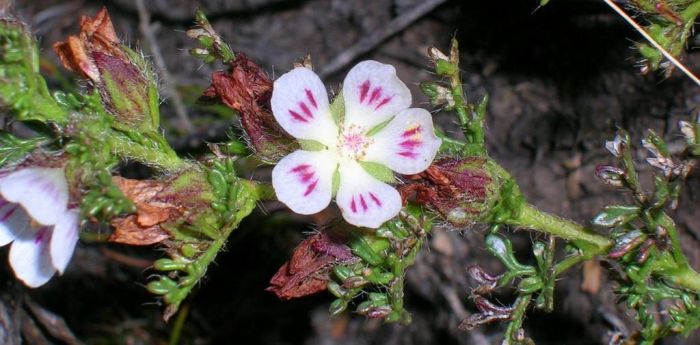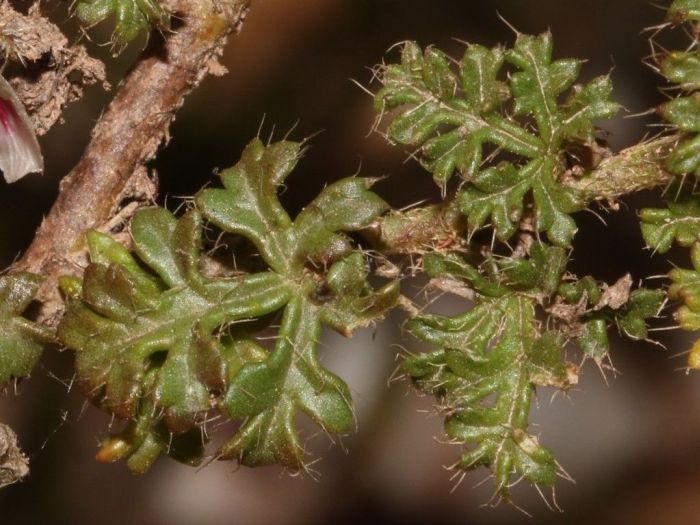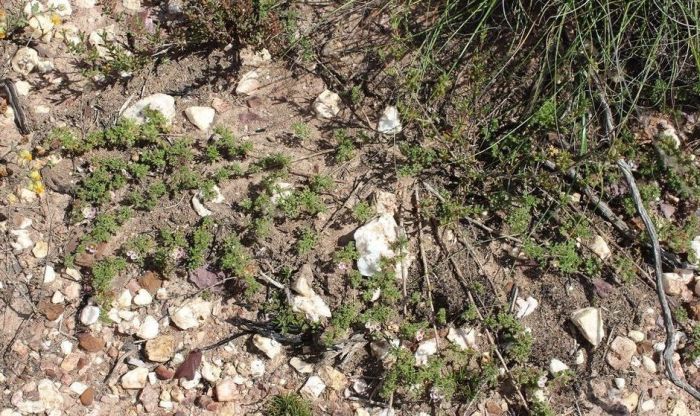Anisodontea dissecta
Anisodontea dissecta (Harv.) Bates.
Family: Malvaceae
Common names: Ruens mallow (Eng.)
Introduction
Anisodontea dissecta is an attractive shrub with a bright showy display of white to light pink flowers to brighten your garden in spring.

Fig. 1: The white to light pink flowers mostly marked with dark pink lines in the middle of Anisodontea dissecta. (Photo by Nick Helme)
Description
Description
Anisodontea dissecta is a sprawling subshrub up to 500 mm tall (Vlok & Schutte-Vlok 2010). The leaves are small, ovate, roughly hairy and deeply 2-palmatisect. Flowers are solitary in the upper axils and about 50 mm in diameter, consisting of white to light pink flowers mostly marked with dark pink lines in the middle (Manning & Goldblatt 2012). The fruit is a schizocarp, splitting into single-seeded parts when ripe, arising from a compound ovary and kept sealed inside the schizocarp (Leistner 2000).

Fig. 2: The small, ovate, roughly hairy and deeply 2-palmatisect leaves of Anisodontea dissecta. (Photo by Brian du Preez)
Anisodontea dissecta can be confused with A. biflora (Desr.) Bates, but can be distinguished from that species by the size of the plant (A. biflora can grow to 1 m tall), shape of the leaves (those of A. dissecta are smaller and dissected) and growth form.
Conservation Status
Status
Anisodontea dissecta is currently listed as Critically Endangered (CR) in the Red List of South African plants. The population is suspected to be fewer than 250 plants and continues to decline because of over-grazing and habitat transformation for crop cultivation (Raimondo & Helme 2019).
The conservation status of this species has over the years been uncertain and confusing largely because of a lack of a proper taxonomic treatment of the species. Hall et al. (1980) assessed the species and came to the conclusion that its conservation status was uncertain as a consequence of habitat loss and invasive alien species. Later, Hilton-Taylor (1960) assessed the species and considered it to be vulnerable because of further habitat loss. Recently Raimondo et al. (2009) assessed the species and came to the conclusion that it was critically endangered. In their assessment they found 5, small, severely fragmented subpopulations that consisted of fewer than 50 plants per subpopulation because of more than 70% of the habitat having been transformed for crop cultivation.

Fig. 3: The sprawling habit of Anisodontea dissecta. (Photo by Brian du Preez)
Distribution and habitat
Distribution description
The species is restricted to the Western Cape Province, from Bredasdorp to Kogmanskloof and Potberg (Manning & Goldblatt, 2012). The species is often found on disturbed stony clay soils on lower slopes (Vlok & Schutte-Vlok 2010).
Derivation of name and historical aspects
History
Anisodontea is a genus of 21 perennial shrubs or shrublets, distributed from the Northern Cape right down to the Cape Peninsula and Saldanha Bay and across to the Eastern Cape and as far north as KwaZulu-Natal (Bandenhorst 2005; Stoll 2011). The genus is predominant in the Karoo and Fynbos Biomes. Anisodontea is recognised by the presence of 3–5 bracts that appear on the flower stalk (Vlok & Schutte-Vlok 2010).
The specific epithet ‘dissecta’ refers to the deeply divided leaves into many lobes of the plant.
Anisodontea dissecta had until Bates (1969), been known under Malvastrum dissectum Harv.

Fig. 4: The solitary flowerheads in the upper axils of Anisodontea dissecta. (Photo by Brian du Preez)
Ecology
Ecology
Anisodontea dissecta flowers in spring (and soon after a fire) between September and October (Vlok & Schutte-Vlok 2010; Manning & Goldblatt 2012). The species is often abundant in disturbed clayey soil on lower slopes (Vlok & Schutte-Vlok 2010). The fruit (a schizocarp) becomes hard as they mature and develop a thick wall, and are dispersed by grazing animals, birds and humans (Leistner 2000). Anisodontea dissecta prefers and thrives inland, unlike A. biflora which prefers coastal environment (Manning & Goldblatt 2012).
Uses
Use
None recorded. However, it has horticultural potential.
Growing Anisodontea dissecta
Grow
There is no knowledge on cultivation requirements currently, however, cultivation techniques suggested for other species in the genus such as Anisodontea julii and Anisodontea scabrosa are likely to apply. For these species, it is recommended that plants be exposed to full sun and watered regularly, occasionally compost may be added. Plants prefer sandy, clay or loamy soils. Pruning regularly is advised to keep the plant clean and neat, and pinch out the growing tips to encourage bushiness. Plants grown from seed may, however, not resemble the parent plant, as Anisodontea is known to hybridize freely (Badenhorst 2005).
References
- Badenhorst, L. 2005-03. Anisodontea julii (Burch. ex DC.) Bates. (Malvaceae). PlantZAfrica. Online. http://pza.sanbi.org/anisodontea-julii.
- Bates, D.M. 1969. Systemic of the South African Genus Anisodontea. Gentes Herbarium (P215–383). Volume 10.
- Hall, A.V., De Winter, M., De Winter, B. & Van Oosterhout, S.A.M. 1980. Threatened plants of southern Africa. South African National Scientific Programmes Report 45. CSIR, Pretoria.
- Harvey, W.H. & Sonder, O.W. 1860. Flora capensis: being a systematic description of the plants of the Cape Colony, Caffraria, & Port Natal. Volume 1.
- Hilton-Taylor, C. 1996. Red Data List of Southern African Plants. National Botanical Institute, Pretoria
- Leistner, O.A. (ed.). 2000. Seed plants of southern Africa: families and genera. Strelitzia 10. National Botanical Institute, Pretoria.
- Manning, J. & Goldblatt, P. 2012. Plants of the Greater Cape Floristic Region 1: the Core Cape Flora. Strelitzia 29. South African National Biodiversity Institute, Pretoria.
- Raimondo, D. & Helme, N.A. 2009. Anisodontea dissecta (Harv.) Bates. National Assessment: Red List of South African plants version 2020.1. Accessed on 2020/07/09.
- Stoll, N. 2011-05. Anisodontea scabrosa (L.) Bates. (Malvaceae). PlantZAfrica. Online, http://pza.sanbi.org/anisodontea-scabrosa.
- Vlok, J. & Schutte-Vlok, A-L. 2015. Plants of the Klein Karoo. Umdaus Press, Hatfield.
Credits
Lindokuhle Sibisi and Luvo Magoswana
Compton Herbarium
October 2020
Plant Attributes:
Plant Type: Shrub
SA Distribution: Western Cape
Soil type: Clay, Loam
Flowering season: Spring
PH: Neutral
Flower colour: White, Pink
Aspect: Full Sun
Gardening skill: Average
Special Features:
Horticultural zones







Rate this article
Article well written and informative
Rate this plant
Is this an interesting plant?
Login to add your Comment
Back to topNot registered yet? Click here to register.